Alternating Groups 3
Problem
There are some red and blue tiles arranged circularly. You are given an array of integers colors and a 2D integers array queries.
The color of tile i is represented by colors[i]:
colors[i] == 0means that tileiis red.colors[i] == 1means that tileiis blue.
An alternating group is a contiguous subset of tiles in the circle with alternating colors (each tile in the group except the first and last one has a different color from its adjacent tiles in the group).
You have to process queries of two types:
queries[i] = [1, sizei], determine the count of alternating groups with sizesizei.queries[i] = [2, indexi, colori], changecolors[indexi]tocolori.
Return an array answer containing the results of the queries of the first type in order.
Note that since colors represents a circle, the first and the last tiles are considered to be next to each other.
Examples
Example 1:
Input: colors = [0,1,1,0,1], queries = [[2,1,0],[1,4]]
Output: [2]
Explanation:
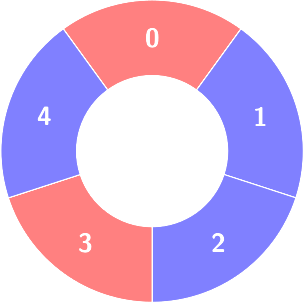 **
First query:
Change
**
First query:
Change colors[1] to 0.
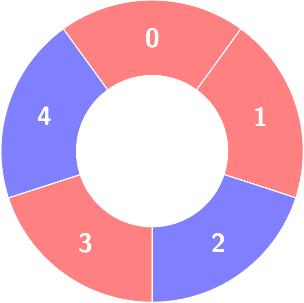
Second query:
Count of the alternating groups with size 4:
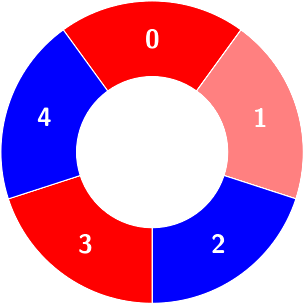
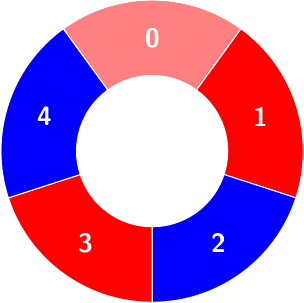
Example 2:
Input: colors = [0,0,1,0,1,1], queries = [[1,3],[2,3,0],[1,5]]
Output: [2,0]
Explanation:
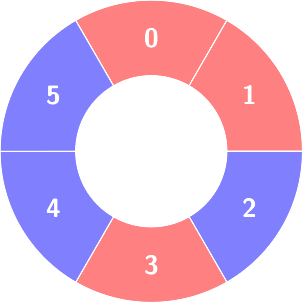 First query:
Count of the alternating groups with size 3:
First query:
Count of the alternating groups with size 3:
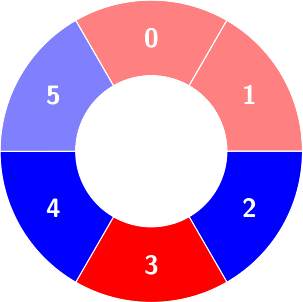
 Second query:
Second query: colors will not change.
Third query: There is no alternating group with size 5.
Constraints:
4 <= colors.length <= 5 * 10^40 <= colors[i] <= 11 <= queries.length <= 5 * 104queries[i][0] == 1orqueries[i][0] == 2- For all
ithat:queries[i][0] == 1:queries[i].length == 2,3 <= queries[i][1] <= colors.length - 1queries[i][0] == 2:queries[i].length == 3,0 <= queries[i][1] <= colors.length - 1,0 <= queries[i][2] <= 1
Solution
Method 1 – Sliding Window with Circular Handling
Intuition
The key idea is to use a sliding window of the required size to check for alternating groups efficiently. Since the array is circular, we need to handle wrap-around cases. For updates, we simply change the color and process queries as needed.
Approach
- Sliding Window for Alternating Groups:
- For a query
[1, size], slide a window of lengthsizeover the array. - For each window, check if the colors alternate (i.e., adjacent tiles have different colors).
- Since the array is circular, extend the array by concatenating the first
size-1elements to the end for wrap-around. - Count all valid windows.
- Processing Updates:
- For a query
[2, idx, color], updatecolors[idx]tocolor.
- Handling Queries:
- Iterate through queries, process each according to its type, and collect answers for type 1 queries.
- Edge Cases:
- Ensure window does not double-count groups due to circularity.
- Only consider windows starting within the original array length.
Code
C++
class Solution {
public:
vector<int> alternatingGroups(vector<int>& colors, vector<vector<int>>& queries) {
int n = colors.size();
vector<int> ans;
for (auto& q : queries) {
if (q[0] == 2) {
colors[q[1]] = q[2];
} else {
int sz = q[1];
int cnt = 0;
// Create extended array for circular window
vector<int> ext(colors.begin(), colors.end());
ext.insert(ext.end(), colors.begin(), colors.begin() + sz - 1);
for (int i = 0; i < n; ++i) {
bool ok = true;
for (int j = i + 1; j < i + sz; ++j) {
if (ext[j] == ext[j - 1]) {
ok = false;
break;
}
}
if (ok) cnt++;
}
ans.push_back(cnt);
}
}
return ans;
}
};
Java
class Solution {
public List<Integer> alternatingGroups(int[] colors, int[][] queries) {
int n = colors.length;
List<Integer> ans = new ArrayList<>();
for (int[] q : queries) {
if (q[0] == 2) {
colors[q[1]] = q[2];
} else {
int sz = q[1], cnt = 0;
int[] ext = new int[n + sz - 1];
System.arraycopy(colors, 0, ext, 0, n);
System.arraycopy(colors, 0, ext, n, sz - 1);
for (int i = 0; i < n; ++i) {
boolean ok = true;
for (int j = i + 1; j < i + sz; ++j) {
if (ext[j] == ext[j - 1]) {
ok = false;
break;
}
}
if (ok) cnt++;
}
ans.add(cnt);
}
}
return ans;
}
}
Python
class Solution:
def alternatingGroups(self, colors: list[int], queries: list[list[int]]) -> list[int]:
n = len(colors)
ans: list[int] = []
for q in queries:
if q[0] == 2:
colors[q[1]] = q[2]
else:
sz = q[1]
cnt = 0
ext = colors + colors[:sz-1]
for i in range(n):
ok = True
for j in range(i+1, i+sz):
if ext[j] == ext[j-1]:
ok = False
break
if ok:
cnt += 1
ans.append(cnt)
return ans
Complexity
- ⏰ Time complexity:
O(Q * N * S)whereQis the number of queries,Nis the length of colors, andSis the group size (worst case up toN). - 🧺 Space complexity:
O(N)for the extended array per query.